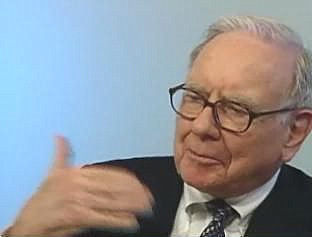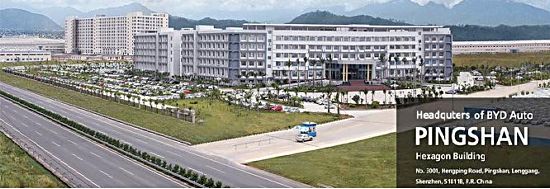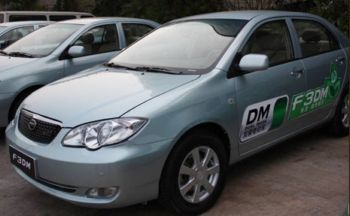
A DECADE and a half ago, if someone were to ask the management at BYD Company Ltd if they envisioned themselves in 2009 being one of the leading automakers in China, they probably would have checked your temperature.
And if you were to say they would also attract nearly two bln hkd for a 9.9% stake from the world’s savviest investment guru, Warren Buffett, perhaps BYD security would be calling the men in the white coats to come and escort you off their premises to a safer, quieter place.
 Warren Buffet paid nearly HK$2 billion for a 9.9% stake in BYD.
Warren Buffet paid nearly HK$2 billion for a 9.9% stake in BYD.
But, as it turns out, all this and much more has been accumulating on the Hong Kong-listed rechargeable battery-cum-automaker’s resume over the past 15 years! BYD, which stands for Build Your Dream, has indeed built its dream.
The company’s Shenzhen-based production facilities were the highlighted stop during a recent visit by several Greater China fund managers eager to understand the company’s impressive growth – both up the value chain, and into completely different chains altogether.
Mr. Wang Haijin, (王海进) BYD’s Investor Relations Department Manager, had a room of fund managers at full attention as he gave the company’s relatively short but illustrious background from rather humble origins to what is today - perhaps one of the most exciting strategic partial assets of Warren Buffet.
“After establishment in 1994 as a computer games outsourcing firm, we picked up Motorola in 2000 – our first foreign client,” Mr. Wang said during the visit organised by Aries Consulting.
Note to potential investor: To go from scratch to bringing onboard one of the world’s best-known high tech players in a mere six years is a feat.
For calendar year 2008, the company was engaged in three separate operations, all under the BYD umbrella.
Namely, they are, in order of importance last year:
1) handset components, revenue from which rose 30% yoy to 11.93 bln yuan, comprising 43% of total revenue;
2) automobile production, up a staggering 77% to 8.65 bln yuan, rising to 32% of total revenue from 23% in 2007, and finally
3) its traditional mainstay, rechargeable battery design and production, revenue from which fell 13% to 6.21 bln yuan.
Further breaking down the battery numbers, revenue from lithium-ion batteries was down 1% at 3.99 bln yuan, while nickel batteries fell 26% to 2.97 bln yuan.
Batteries now make up only around 20% of total revenue, Mr. Wang said, a major shift from the companies pioneer days when rechargeable batteries were its bread and butter. BYD is still a giant among battery producers, last year producing 65% of the world’s nickel-cadmium batteries and 30% of the world's lithium-ion mobile phone batteries.
“Sales of nickel batteries last year dropped because of high energy and raw material prices, volatile exchange rates and a poor power tool market from the weak US economy.”
The good news is, the company is not downsizing its battery ops per se, but is definitely getting a more sustainable charge from creating the entire package, whether it be the cell phone which houses the battery, or an entire automobile build around it – and it is surely this operation-wide transformation that first garnered the attention of Mr. Buffett halfway around the world in Nebraska.
On the surface, the company had a rather challenging year in 2008, but a look behind the figures suggests it may be just a bump in the road as the firm makes the shift to becoming a bona-fide automaker.
Overall revenue last year rose 26% to 26.79 bln yuan, but profit attributable to shareholders slipped 37% to 1.02 bln yuan.
“The results were remarkable, considering the global financial crisis,” Mr. Wang said.The less robust net profit last year was fundamentally due to a confluence of two factors: slowing orders from global telecom and power tool buyers, and increased bank borrowings to fund capacity expansion.
End-2008 net assets stood at 13.34 bln yuan vs 12.41 bln a year earlier, while total assets rose to 32.89 bln yuan compared with 29.29 bln.
Due to increased borrowing, the end-2008 net gearing ratio was 66 pct vs 24 pct at the end of 2007.
But, after all, this increased capital expenditure is to be expected from an ambitious company that is moving into the ultra-competitive world of manufacturing cars.Mr Wang said BYD continues to display “outstanding performance” in the slowing PRC auto market.
“Last year, we had output of 170.000 units, a one-fold yoy growth. Of this, approximately 140,000 units were of F3 (models), up 60% yoy,” he said.He said new vehicle products were launched to enhance the company’s product portfolio, and they received “an overwhelming response.”
World’s first …

The company’s latest models include the F6, launched in March of 2008, BYD’s first mid-to-high end sedan.Its F0 was launched in September, an economy model targeting the low displacement vehicle market.
“Our F3DM was launched in December, the world’s first new energy vehicle independent of a specialized electric charging station,” Mr. Wang said.
Its F3 ranked one of the top 10 models of sedans for several consecutive months in terms of monthly sales and the best selling model of “self-owned brand sedans” in China.
The F0 ranked among the top 10 brands of sedans in China in terms of monthly sales, and BYD was awarded with “Domestic Brand of the Year” and “Domestic Brand Technology of the Year” in Domestic Motor Brand Awards 2008 at the Guangzhou Motor Expo.
“We aim to capture potential development the automotive sector is one of the industries targeted for assistance in the (4.5 trln yuan) stimulus plan by Chinese government. We expect to maintain rapid growth in 2009 (for our auto operations).”

Mr Wang said BYD plans to “enhance profit by benefiting from economies of scale and lowering the price of raw materials.
“Our group strives to: pursue the development path of ‘self-research and development, self-production and self-owned brands’; launch diversified products with quality and competiveness; strengthen brand awareness and reputation; expand production capacity of new energy vehicles; explore overseas markets, and launch a pure electric vehicle soon.”
He said the “major goal” was to become a market leader in China’s auto market in 2015 and in the world by 2025.
“Over the next two years, we will produce two types of cars, hybrid system, and fully electric. We still rely on imports for most hybrid technology, but we don’t have any production tieups with foreign firms at this point. We strive to rely 100% on our own technology.”
BYD is no longer just a battery maker. That much is clear enough.
And with China’s sales of automobiles in the first quarter surpassing domestic sales in the US for the first time, it is equally clear that this innovative firm is planning to hitch a ride on the back of the auto sector to drive future growth.







